We have actually invested a considerable amount of time over the previous few days staring at the Shader Collection filling screen in a new game called Stalker 2: Heart of Chornobyl. For several of you, the game requires no intro. However truthfully, that experience has actually been more enjoyable than examining half the items we have actually examined in 2024, so probably not also breaking the top 10 most monotonous points I have actually done this year (that was a joke– I like what I do)…
Shader compilation filling screens apart, we have actually taken care of to check Stalker 2 this week, right after the day-one patch was released, benchmarking 31 different GPUs across three resolutions utilizing 3 top quality presets, plus results from quality upscaling (!). So there’s plenty to go over.
Stalker 2 is a first-person shooter/survival scary single-player video game developed making use of Unreal Engine 5 It’s the fourth primary video game in the Stalker series, and amazingly, it’s been 15 years considering that the last release, Telephone call of Pripyat. That video game was a staple for our CPU and GPU testing in the past, so it’s interesting to lastly see a brand-new Stalker title.
So without throwing away anymore time, allow’s get into it. The benchmark pass we made use of for this evaluation occurs in the Lesser Zone, one of the first communities you experience. This area was chosen because it is very demanding on both the CPU and GPU.
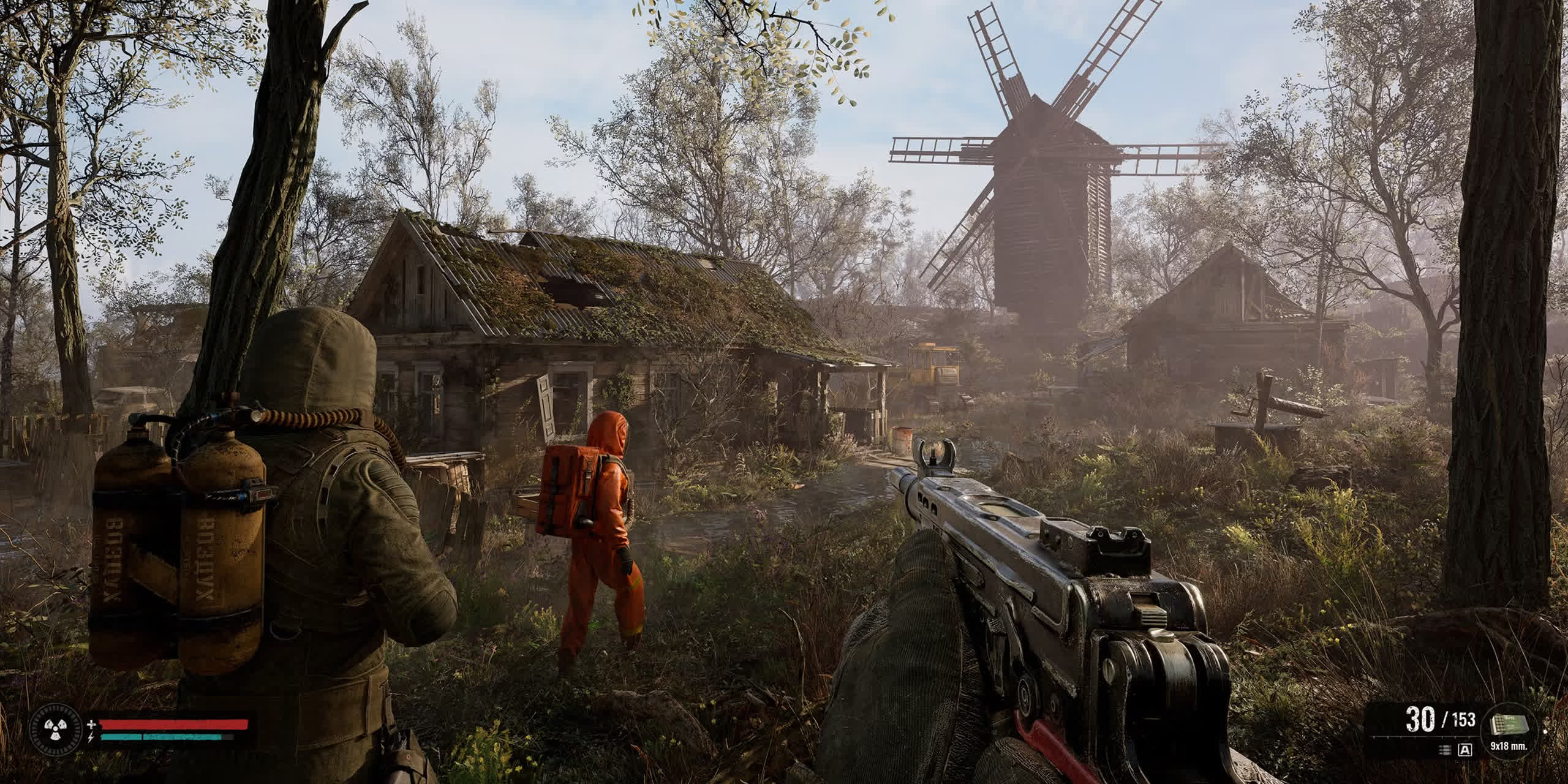
As we just mentioned, we checked numerous quality presets. Changing the quality settings requires rebooting the game, and this causes shader restoring– a process that takes numerous minutes. Executing this procedure at least 3 times per GPU, for an overall of 31 GPUs, made for a fascinating (and prolonged) screening experience.
We examined the Impressive preset both at indigenous resolution and with high quality upscaling, alongside the High and Medium presets. For upscaling, we used DLSS on GeForce GPUs, FSR on Radeon GPUs, and XeSS for the Arc A 770 Although the video game supports FSR and DLSS framework generation, we did not consist of those in this analysis.
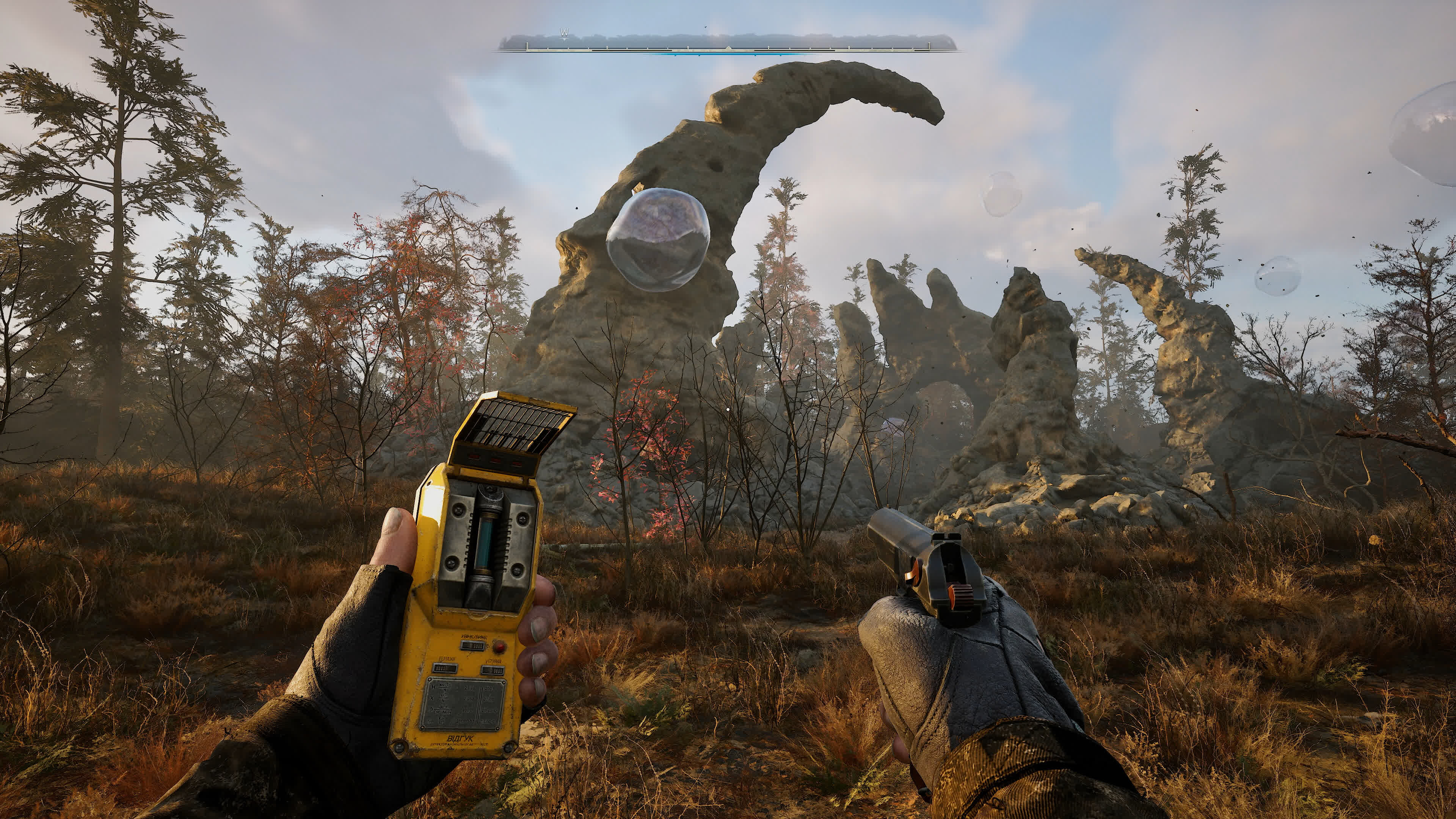
Before diving right into the benchmarks, we intend to attend to the efficiency disparity between 8 GB and 16 GB VRAM GPUs. Several of the upcoming charts will certainly highlight inadequate 8 GB efficiency on the Impressive pre-programmed, even with upscaling made it possible for. To better recognize this, we have actually taken a closer consider the problem.
Criteria
8 GB vs 16 GB VRAM Frame Time Comparison
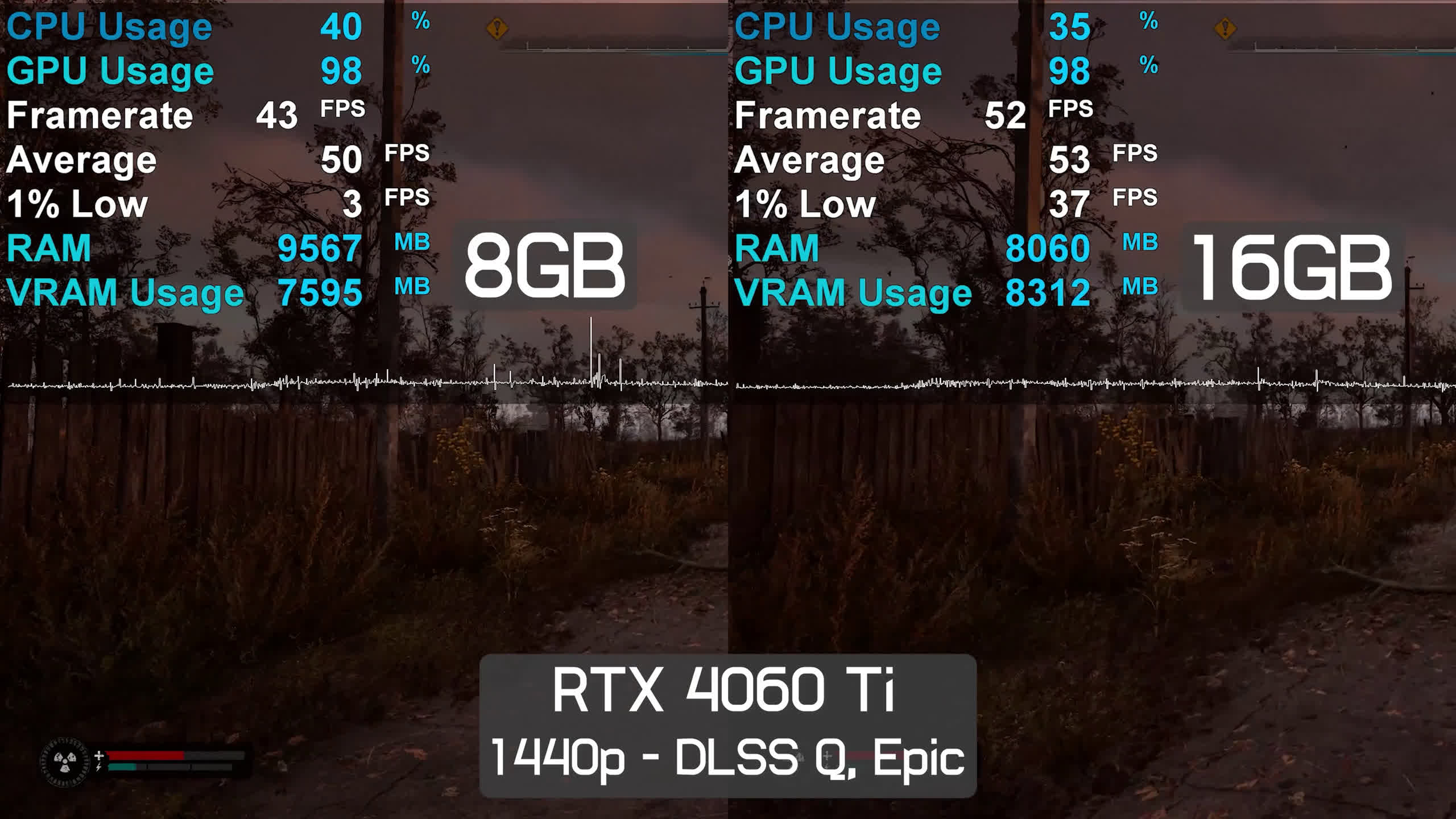
Legendary – 1080 p Native
Starting with the native 1080 p results utilizing the Legendary predetermined, we see the RTX 4090 delivering just over 100 fps in the town utilized for testing. However, this outcome appears to be CPU-limited, despite the fact that screening was carried out with the 9800 X 3 D. This is evident because the RTX 4090 was just 9 % faster than the RTX 4080 Super and 23 % faster than the Radeon RX 7900 XTX. The Radeon GPU’s performance had not been especially remarkable here, approximately matching the RTX 4070 Ti Super, while the RX 7900 XT performed similarly to the RTX 4070 Super.
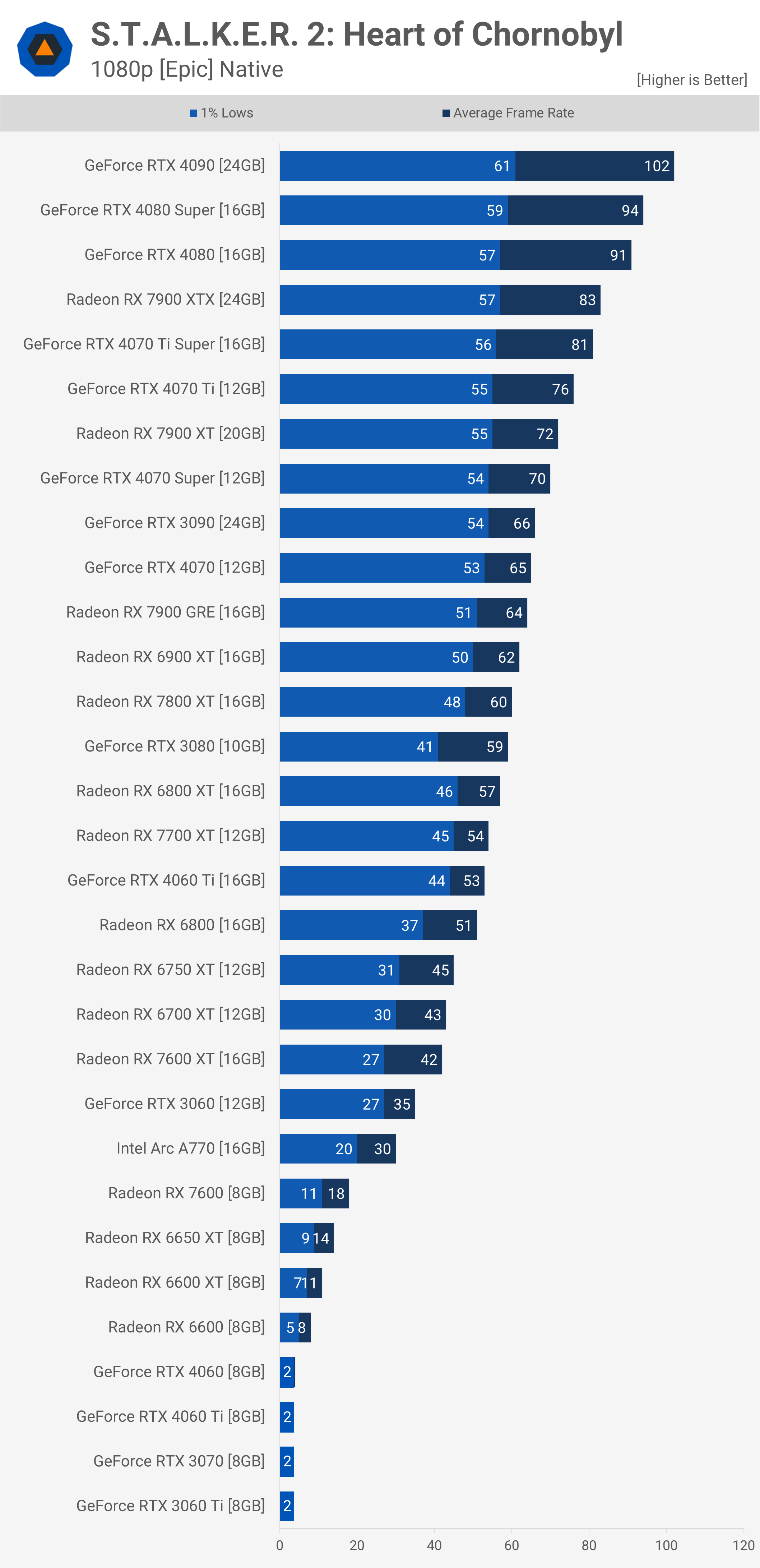
Accomplishing 60 fps at 1080 p needs a minimum of a Radeon RX 7800 XT or RTX 3080 Nevertheless, the previous generation 10 GB GPU revealed some have problem with 1 % lows– not to a disconcerting level, but there were noticeable dips. Speaking of dips, the 8 GB versions were totally unplayable, stopping working to meet appropriate efficiency criteria.
Epic – 1080 p Upscaling
Allowing upscaling substantially improves performance, particularly for lower-end GPUs. The RTX 4090 continued to be CPU-limited, with the RTX 4080, Radeon RX 7900 XTX, and RTX 4080 Super all nearing 100 fps. Achieving 60 fps was now possible with a Radeon RX 6800 XT or a 16 GB RTX 4060 Ti.
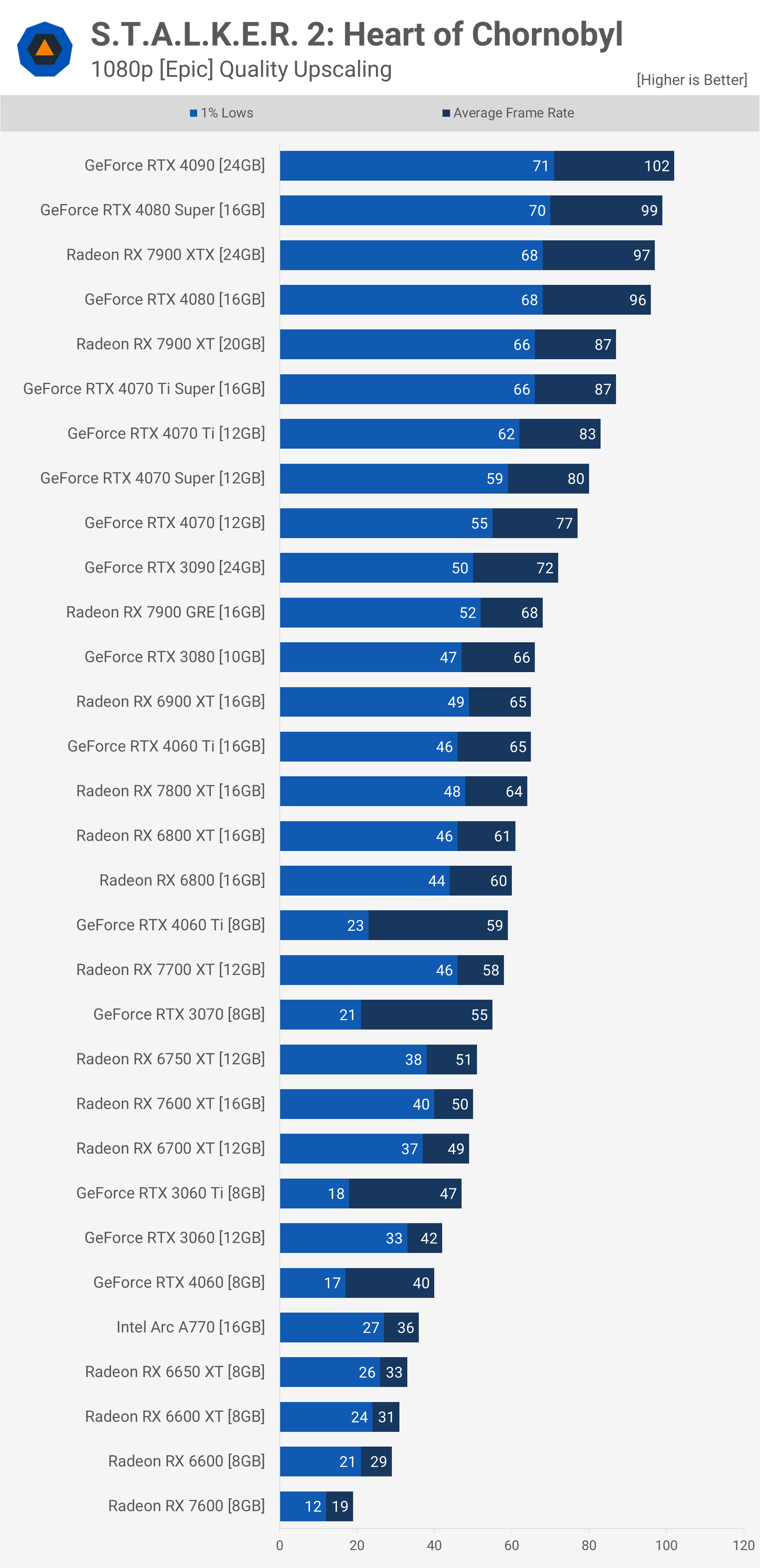
A fascinating observation is that the 16 GB RTX 4060 Ti balanced 65 fps, making it 10 % faster than the 8 GB version. Nonetheless, in terms of 1 % lows, the 16 GB version was 100 % faster, supplying a far better experience. This aligns with searchings for at 1440 p with upscaling.
The takeaway right here is that 8 GB graphics cards encounter performance concerns even at 1080 p with upscaling in this game. Whether future optimizations will resolve this stays unclear, though some enhancement is likely.
Impressive – 1440 p Indigenous
Going up to native 1440 p with the Legendary pre-programmed went down the RTX 4090 to an average of 88 fps. This made it 17 % faster than the RTX 4080 Super, though this margin is smaller than generally expected. Achieving approximately 60 fps currently comes to be really tough, needing at least an RTX 4070 Ti, while the Radeon RX 7900 XT just falls short. Yet point, making it possible for upscaling comes to be required.
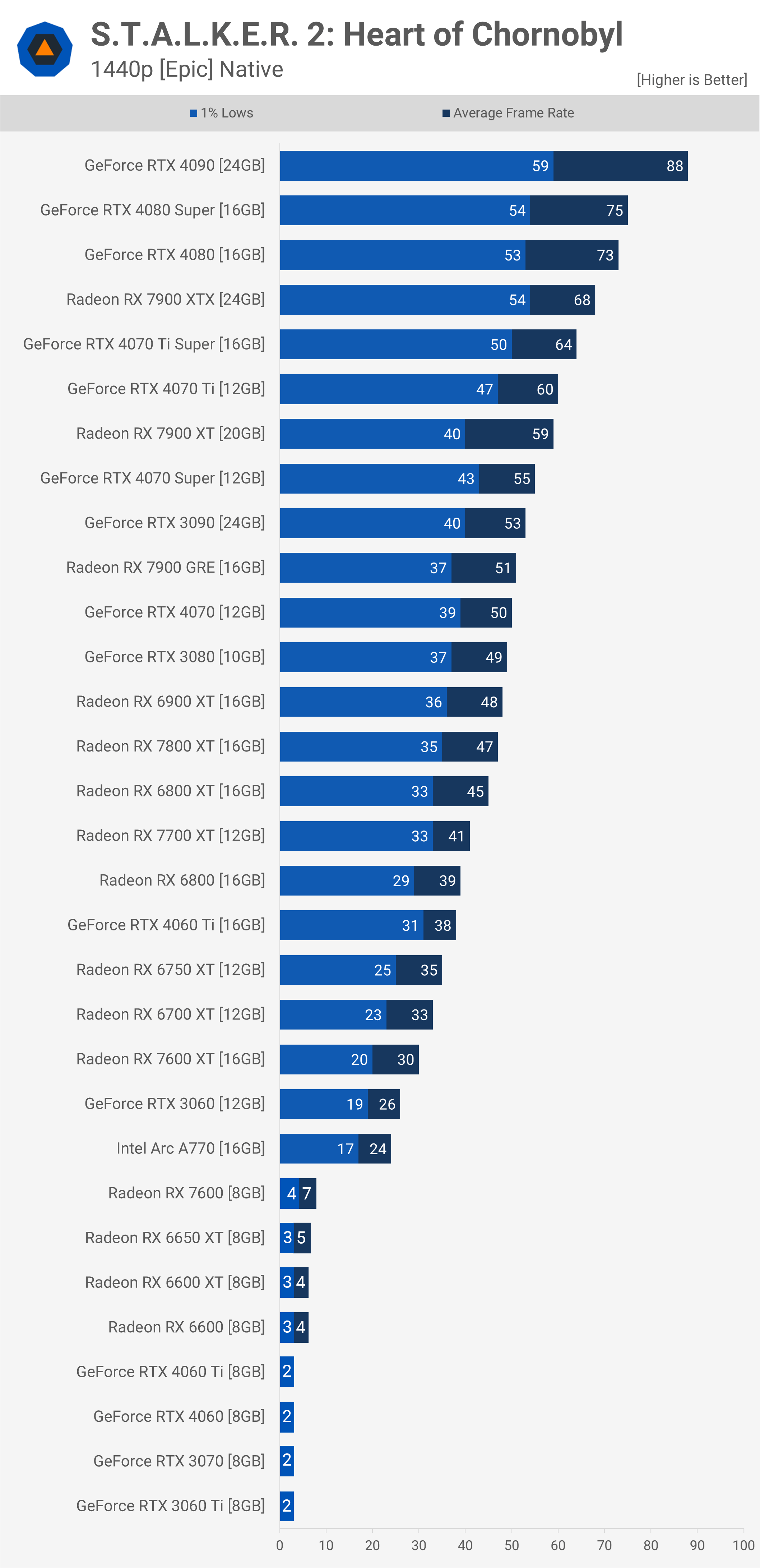
With high quality upscaling allowed– using DLSS for GeForce GPUs, FSR for Radeon GPUs, and XeSS for the Arc A 770– performance improves dramatically across many models. It becomes possible to surpass 60 fps with GPUs like the Radeon RX 7900 GRE, RTX 3090, and RTX 4070
Legendary – 1440 p Upscaling
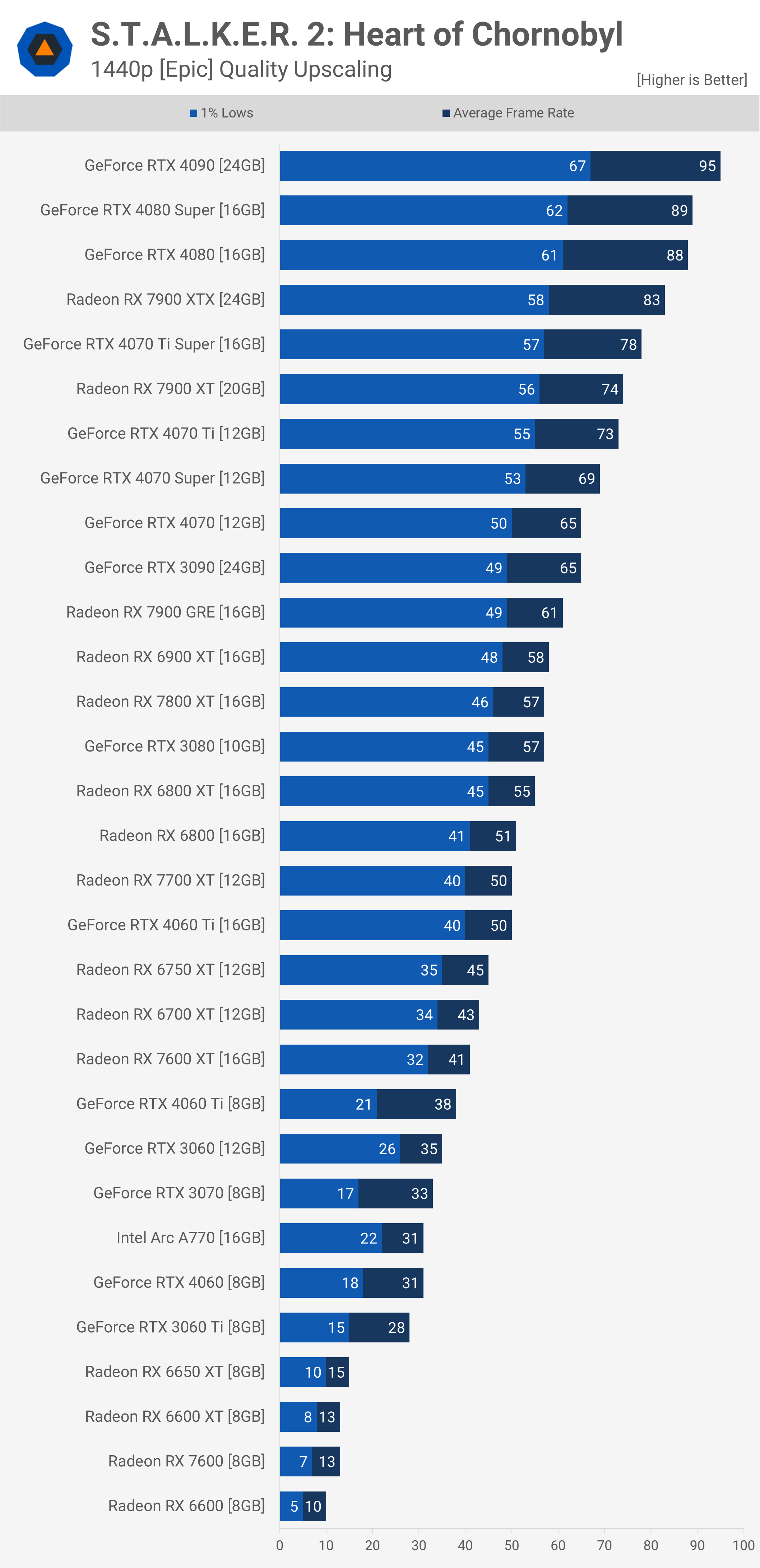
However, 8 GB graphics cards continue to battle, and the outcomes here shouldn’t be analyzed as well actually. Lacking VRAM leads to unpredictable performance, with considerable run-to-run variation. These figures are based on a 3 -run standard, however the inconsistency because of VRAM restrictions implies that 8 GB cards are effectively unplayable at 1440 p with upscaling and the Impressive preset.
Legendary – 4 K Native
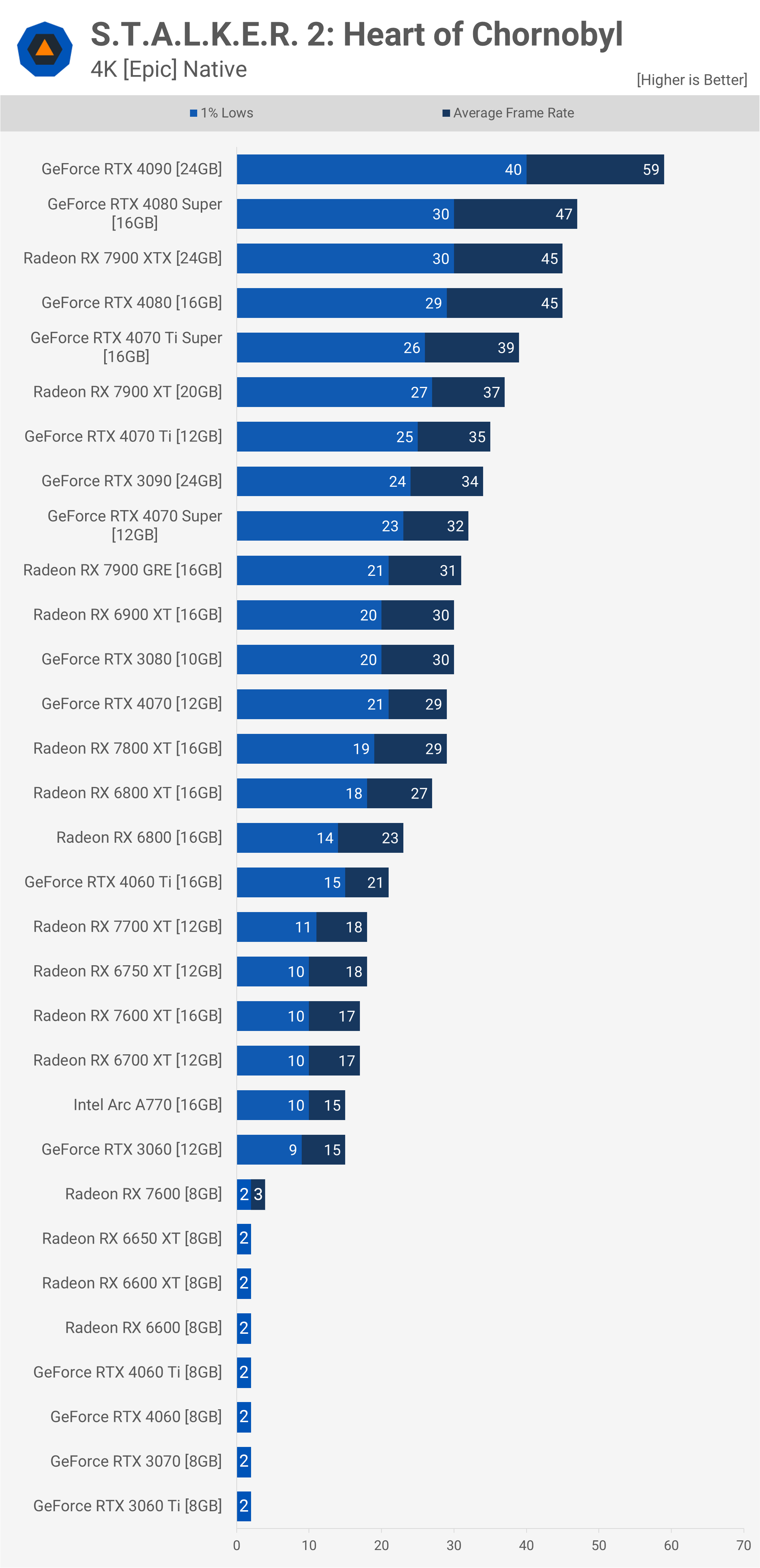
As anticipated, native 4 K is a substantial obstacle. Just the RTX 4090 can deliver close to 60 fps, balancing 60 fps, while the RTX 4080 Super managed simply 47 fps with 1 % lows of 30 fps.
Legendary – 4 K Upscaling
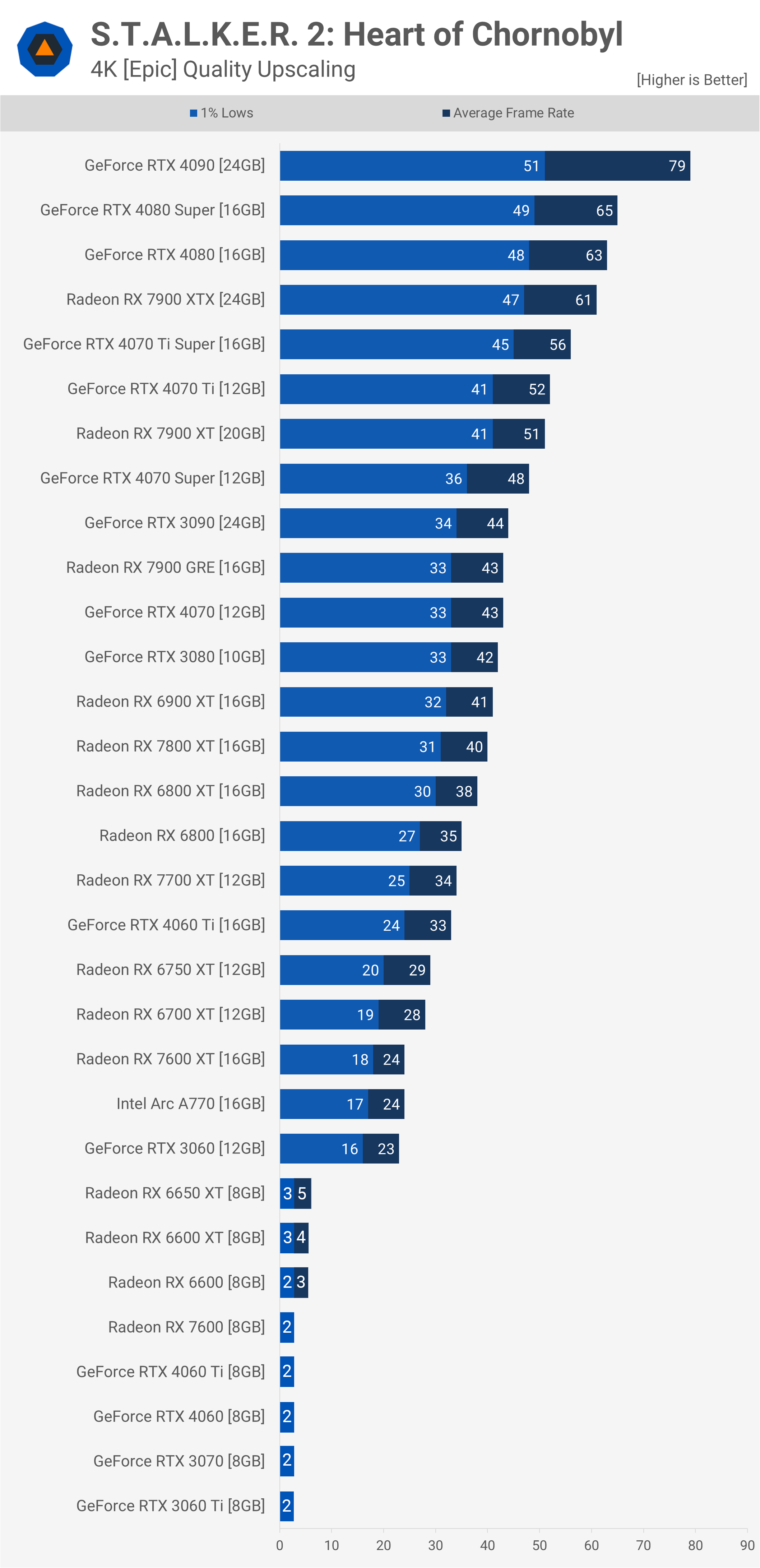
Enabling upscaling at 4 K is a must, and utilizing the high quality mode permits the RTX 4090 to get to an average of 79 fps, supplying a solid experience. The RTX 4080 Super averaged 65 fps, and the Radeon RX 7900 XTX reached 61 fps. While these outcomes are decent, the 1 % lows are noticeable and can influence the overall experience. Individuals might take into consideration evaluating the well balanced upscaling option or going down the resolution to 1440 p for smoother gameplay.
High – 1080 p
Additionally, you can attempt the High predetermined, so let’s start at 1080 p. At the high-end, the information stays mainly CPU-limited, though we managed to rise to 112 fps with the RTX 4090 It’s additionally currently feasible to average 60 fps with the Radeon RX 7700 XT or the 8 GB RTX 4060 Ti. This means 8 GB graphics cards are running within their VRAM limits using the High pre-programmed at indigenous 1080 p, which is a favorable advancement. Furthermore, structure rates around 50 fps are possible with GPUs like the RX 7600 XT and RTX 4060
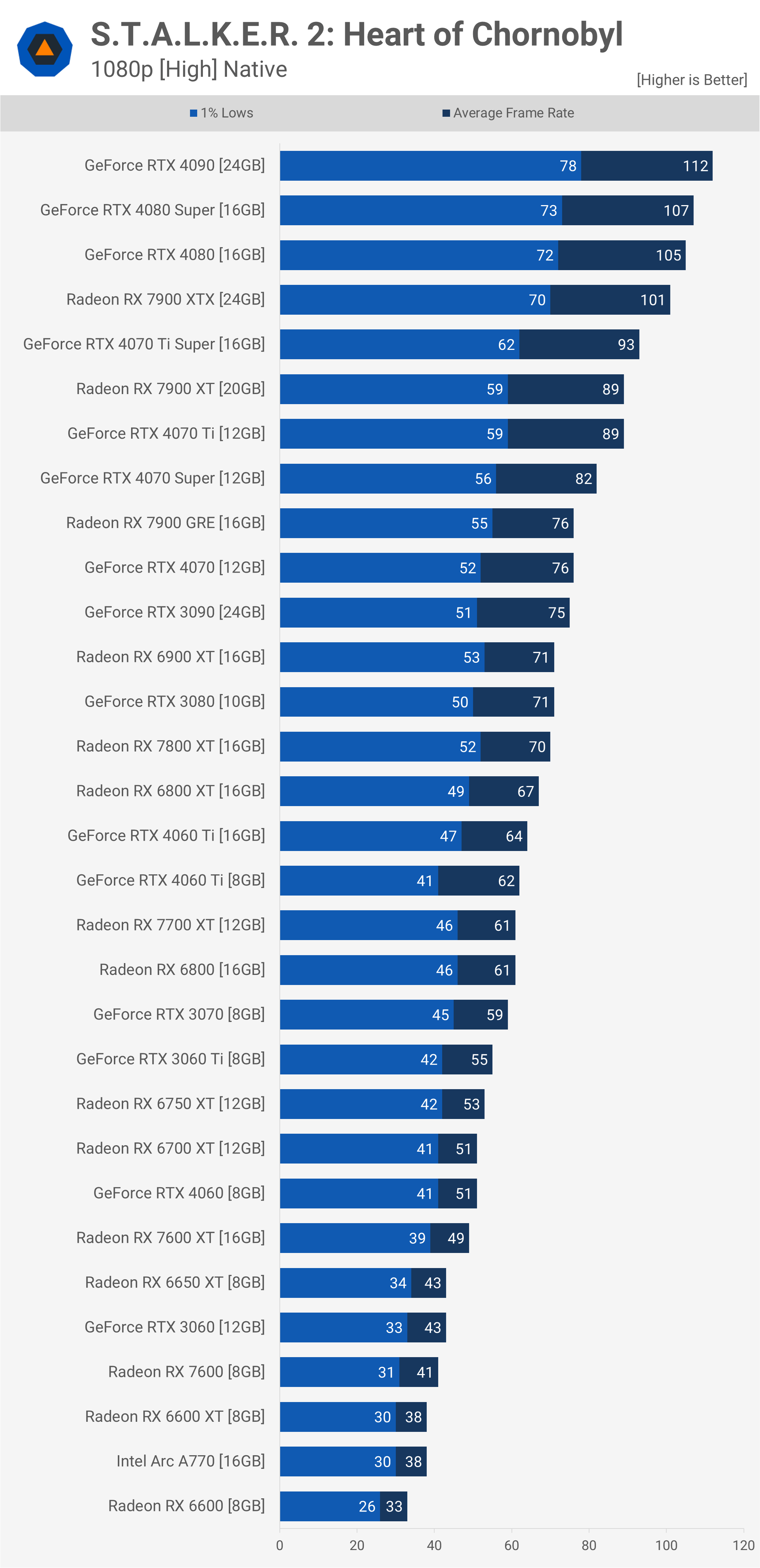
High – 1440 p
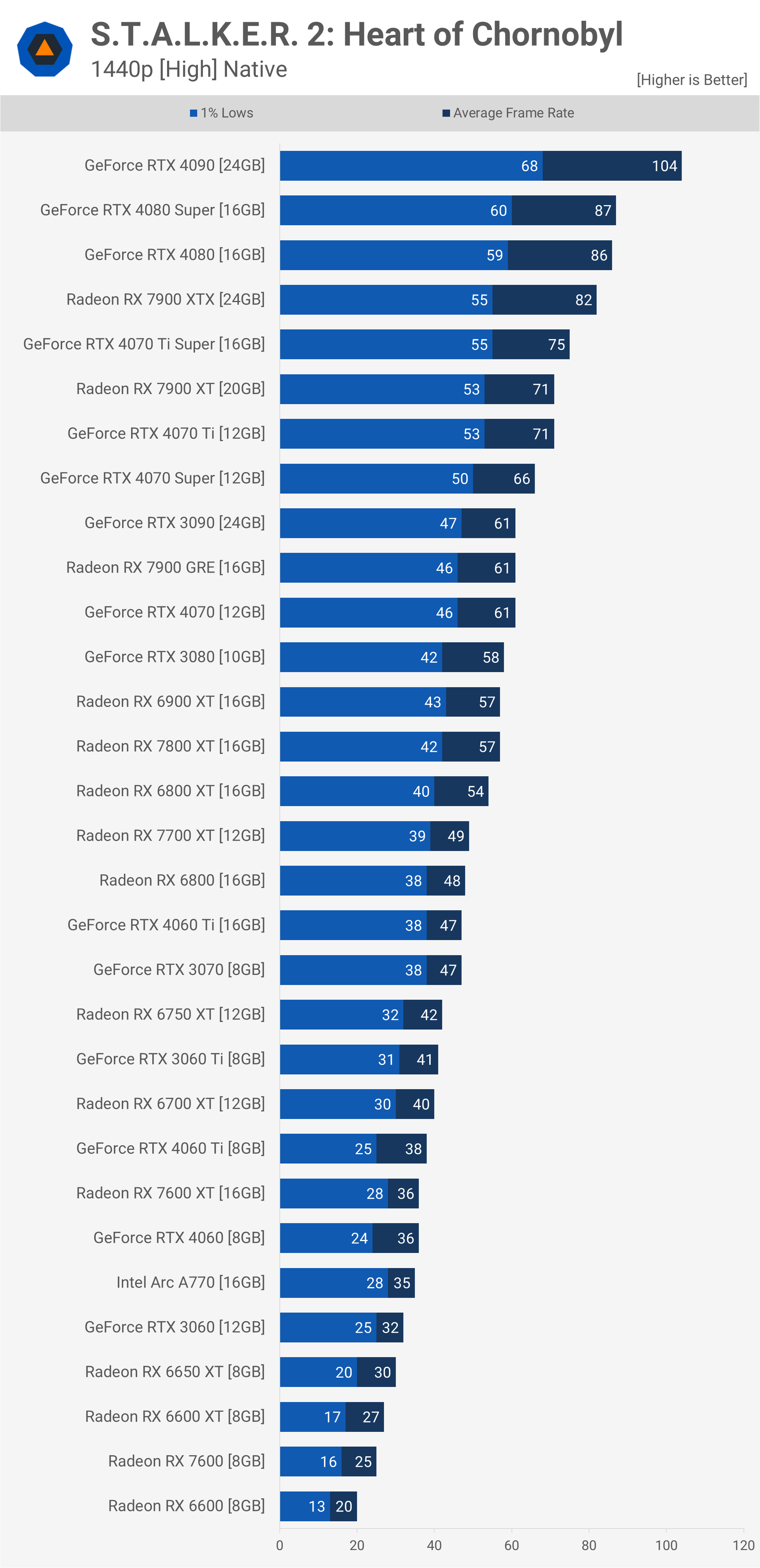
At 1440 p, the RTX 4090 still appears rather CPU-limited, achieving 104 fps– a 20 % boost over the RTX 4080 Super. At the same time, AMD’s top entertainer, the RX 7900 XTX, was just 5 % slower than the RTX 4080 Attaining 60 fps currently needs a GPU like the RTX 4070, RX 7900 GRE, or RTX 3090, suggesting hefty GPU needs for 1440 p pc gaming with the second-highest quality preset.
High – 4 K
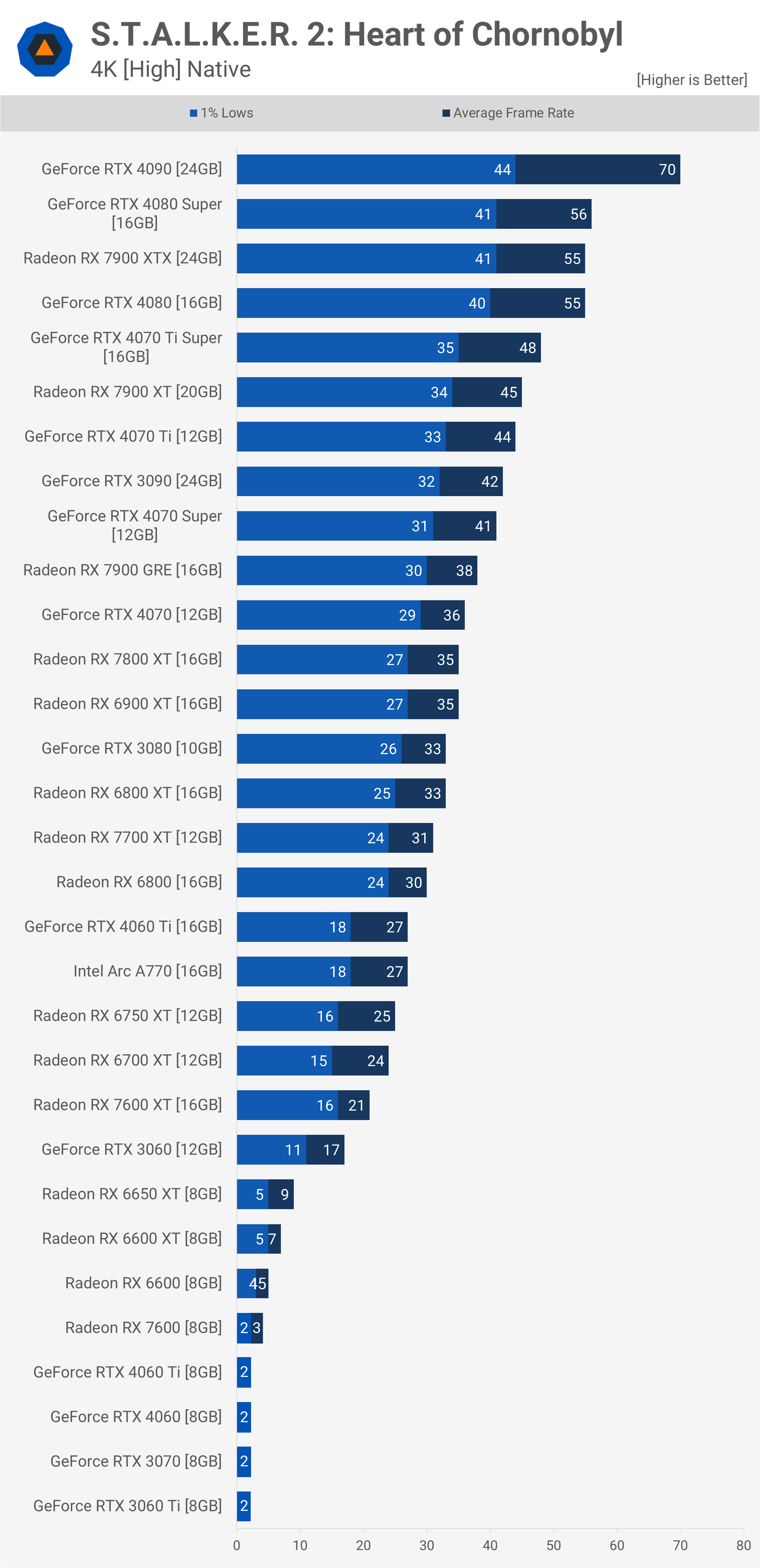
At 4 K, very few GPUs can going beyond 60 fps. As a matter of fact, only the RTX 4090 managed to average 70 fps, while the RTX 4080, RX 7900 XTX, and RTX 4080 Super all floated in the mid- 50 s.
Medium – 1080 p
Utilizing the Medium top quality preset at native 1080 p enabled structure rates to raise to 121 fps, though efficiency continues to be heavily CPU-limited. The only factor for the enhanced framework price contrasted to the High and Epic presets is the reduced CPU tons.
While it’s unclear which certain settings caused this change (after spending a number of days evaluating 31 GPUs throughout three resolutions with 4 quality arrangements), settings like making distance and level of detail generally affect CPU tons. This highlights why screening CPU performance with low-quality setups is typically unsuitable beyond competitive shooters.
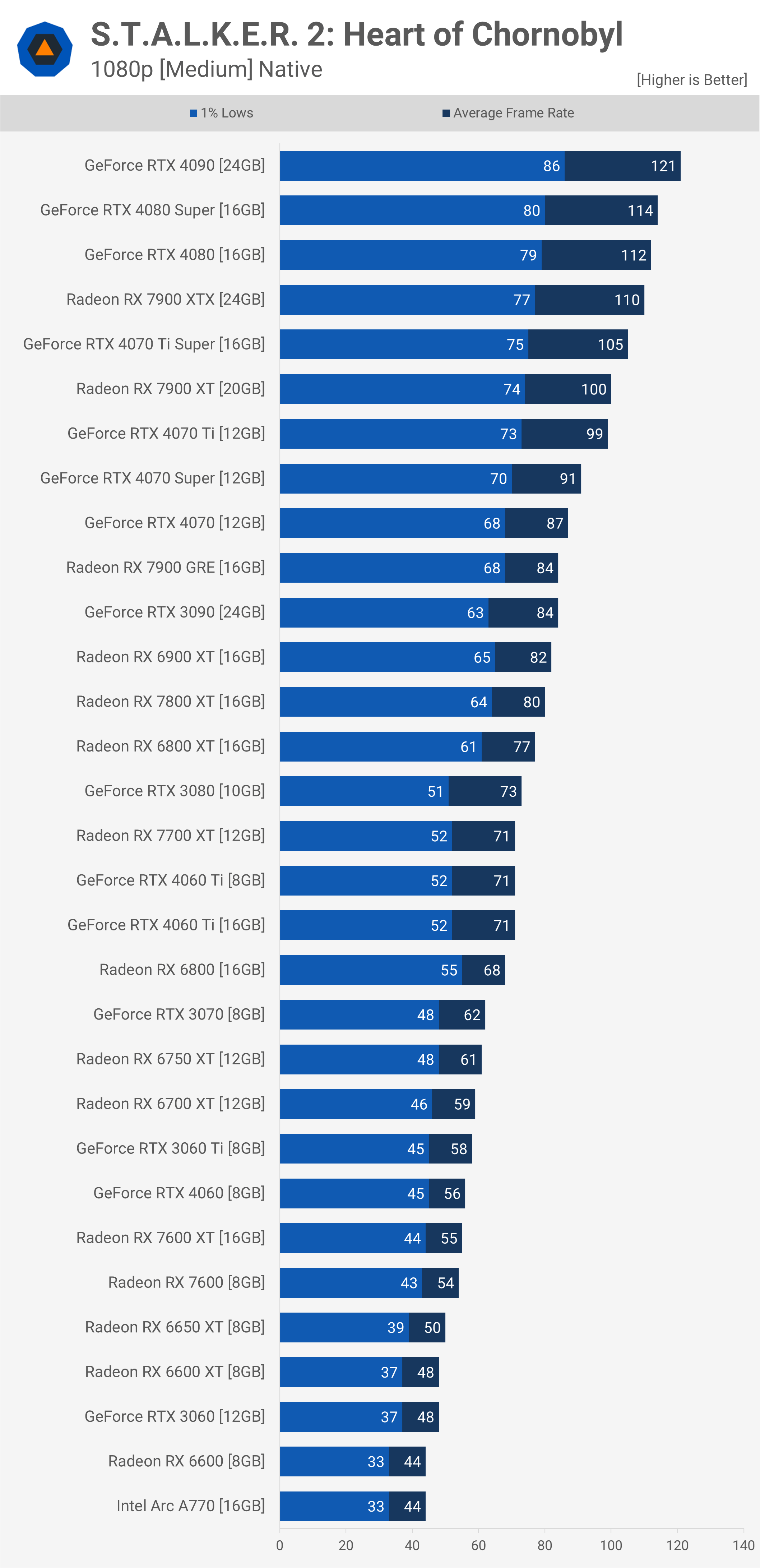
With the Medium pre-programmed, the RTX 4090 was just 6 % faster than the RTX 4080 Super and 10 % faster than the RX 7900 XTX. Attaining 100 fps or even more was now feasible with GPUs like the RX 7900 XT, while the majority of GPUs gave a 60 fps or much better experience. For example, the previous-generation RX 6750 XT averaged 61 fps, making Tool a solid option for boosting performance.
Medium – 1440 p
Raising the resolution to 1440 p dropped the RTX 4090’s performance to 113 fps, that made it 18 % faster than the RTX 4080 Super and 26 % faster than the RX 7900 XTX. However, the Radeon GPU still executed well, averaging 90 fps.
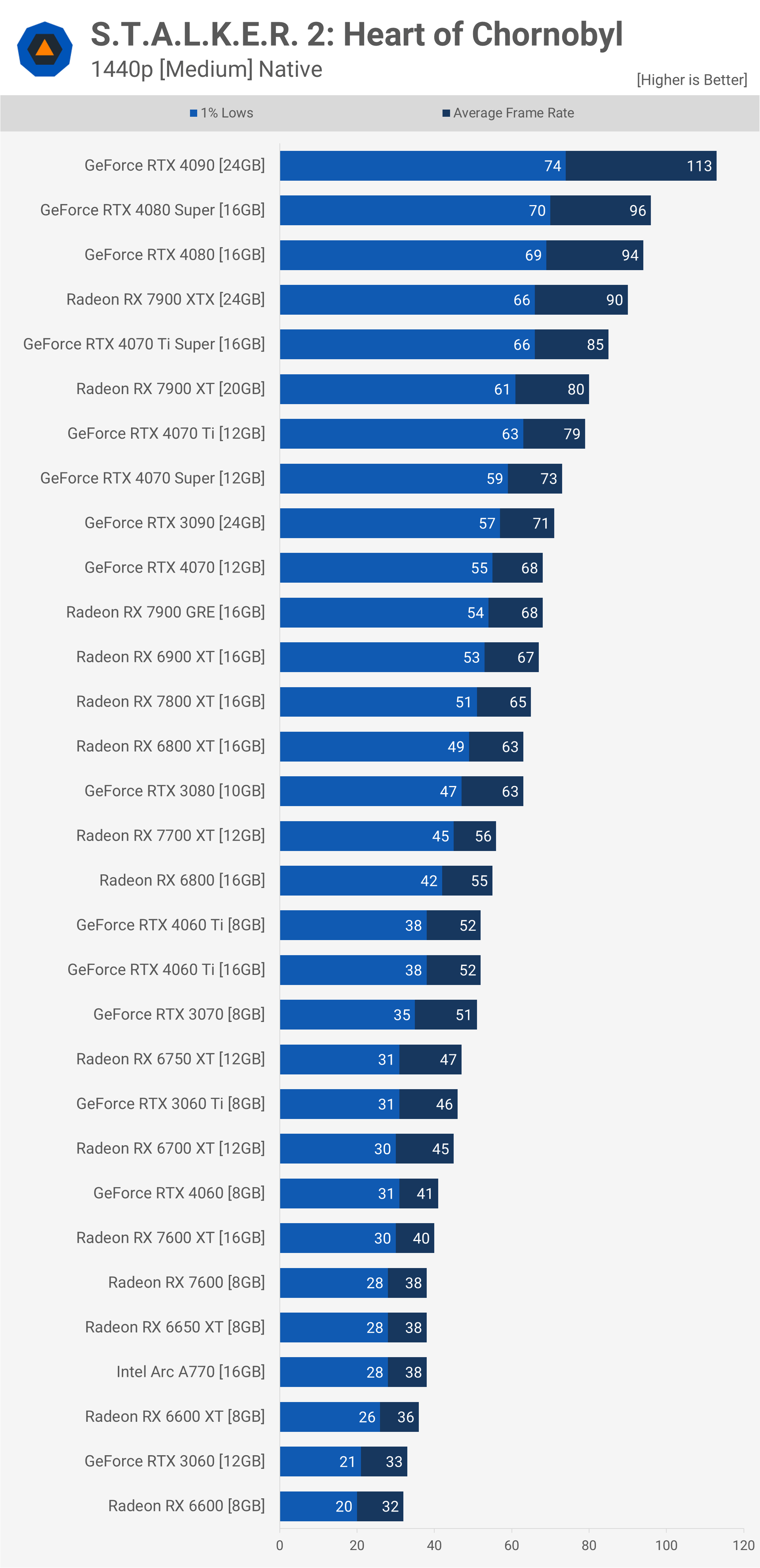
For 60 fps or far better, the RX 6800 XT or RTX 3080 executed efficiently, while current-generation alternatives like the RX 7800 XT or RTX 4070 likewise provided solid results.
Tool – 4 K
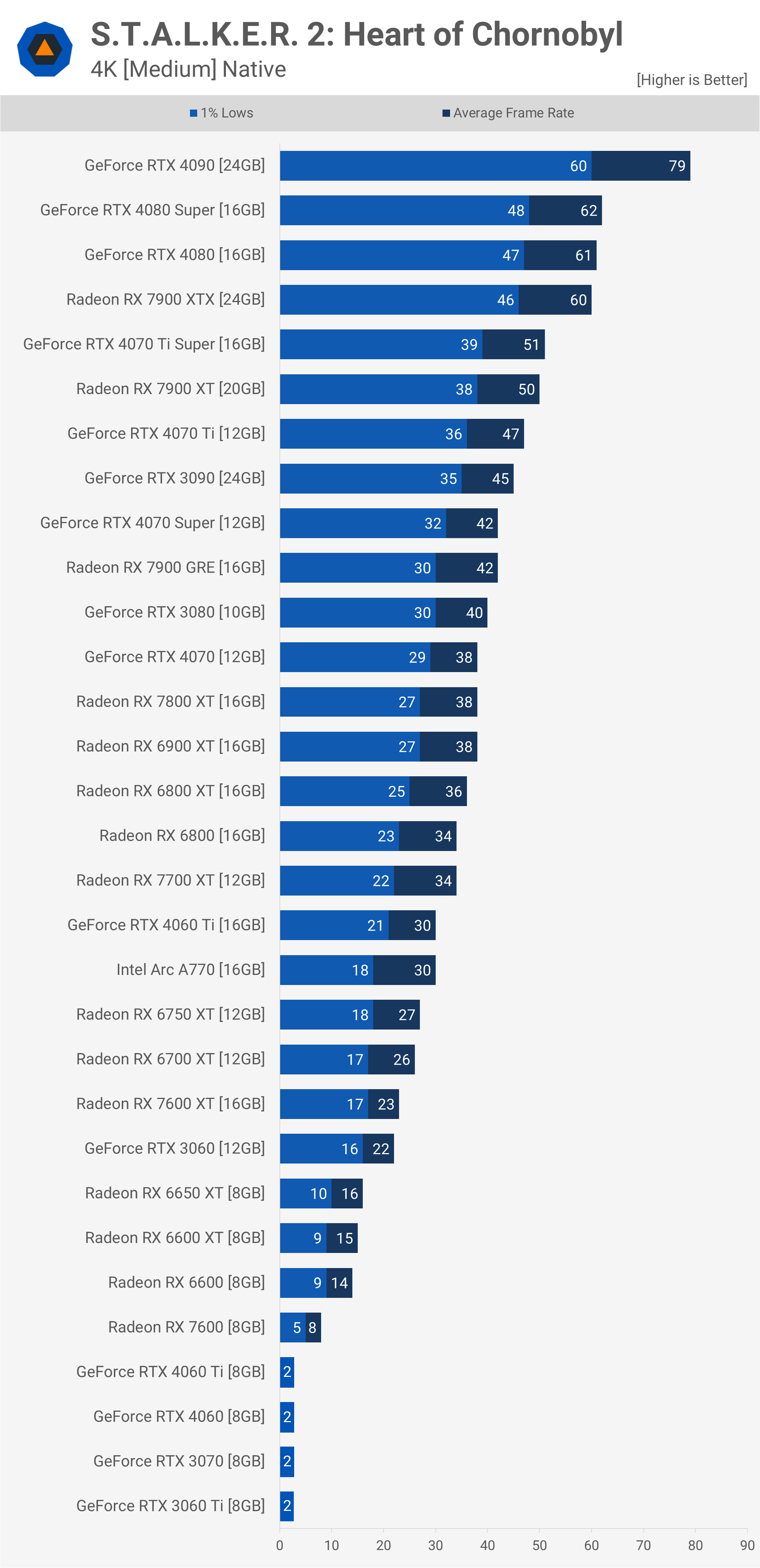
Finally at 4 K it’s feasible to render 60 fps or more at the native resolution using either the 7900 XTX, 4080, 4080 Super or 4090 Listed below that you will certainly wish to make it possible for upscaling.
Pressing the Limitations in Stalker 2
Stalker 2 is an unbelievably comprehensive computer game, and therefore, it is exceptionally requiring. That stated, we are confident there is space for additional optimization, though to what degree continues to be challenging to determine right now.
Thankfully, this isn’t a game where you require huge frame rates to appreciate it. Ideally, we would certainly aim for around 100 fps, however that’s a significant obstacle today. A more realistic target for many arrangements is 60 fps, offered you want to tinker with the quality settings.
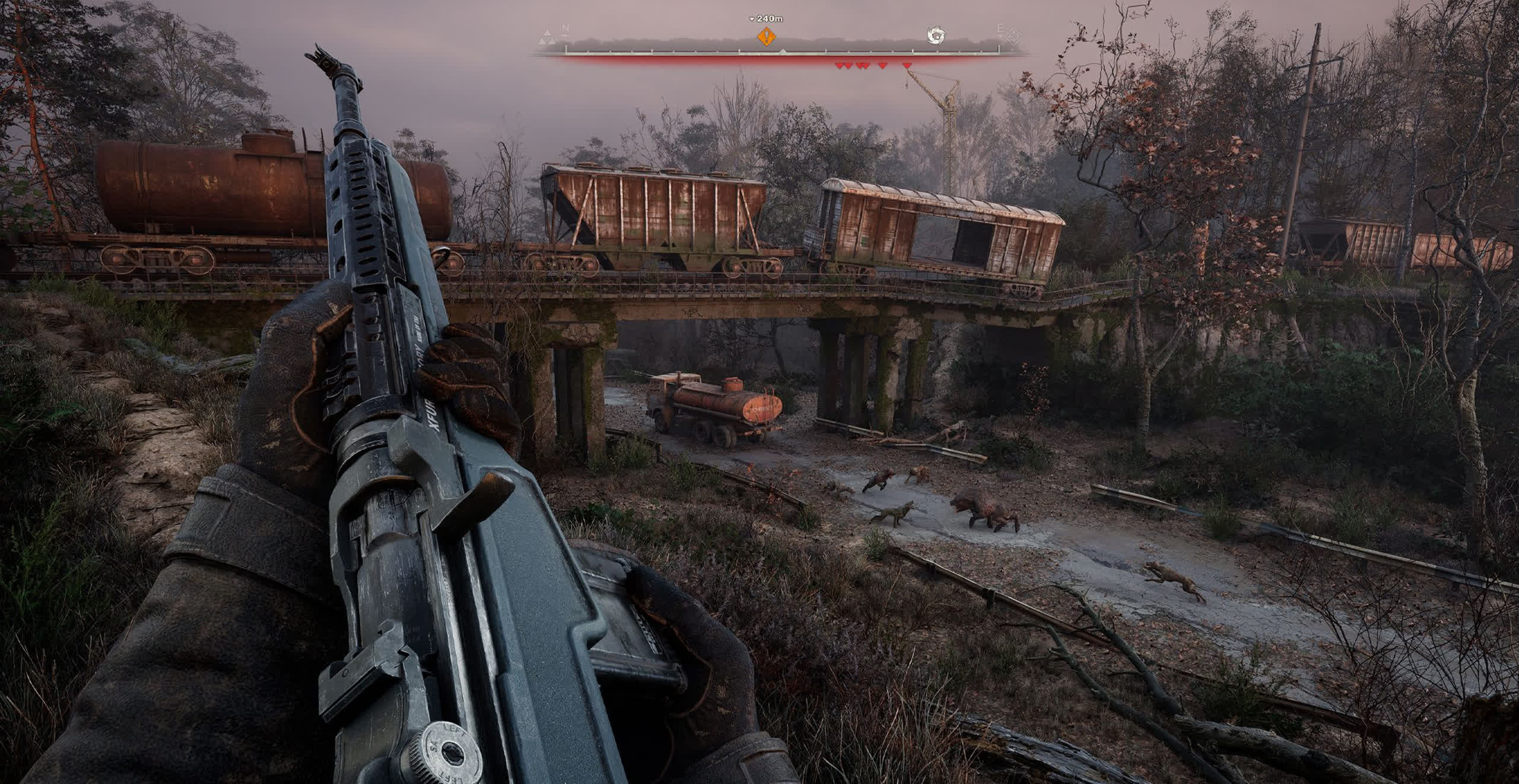
Several players are likely to run into CPU restrictions with this title, a trend we have actually observed in several current releases. The game is specifically CPU-heavy arounds and negotiation areas. Open-world video games with NPCs and AI often place greater pressure on the CPU than various other sorts of games, and in this instance, it’s perhaps exacerbated by Unreal Engine 5
Decreasing high quality setups has minimal influence on CPU performance in demanding areas though. Turning down setups mainly enhances performance in less demanding regions, creating a larger FPS inconsistency in between the lighter, open locations and the heavier community environments. This difference will certainly be especially noticeable on mid-range CPUs.
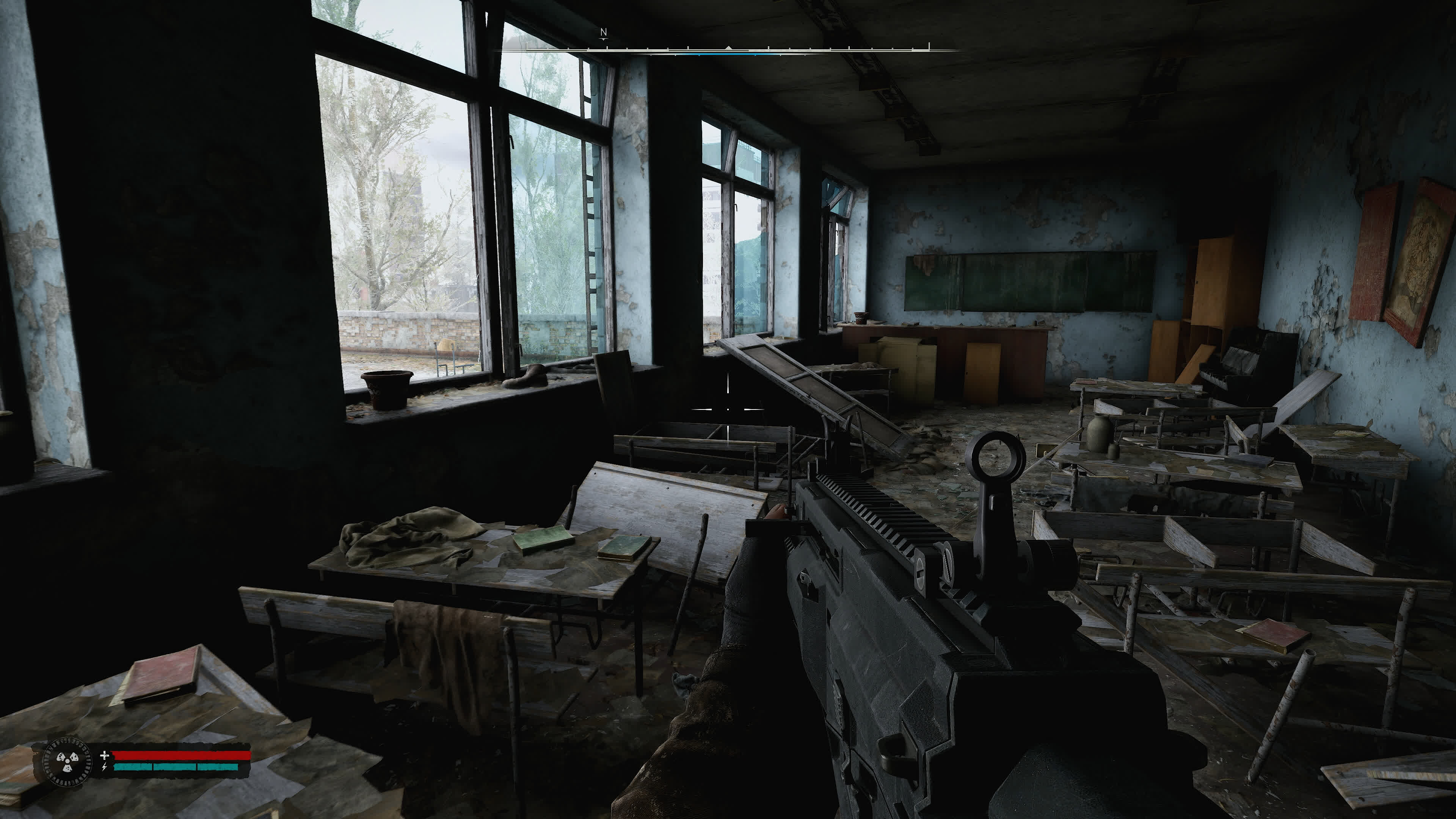
An additional significantly typical pattern, as we forecasted a couple of years ago, is the fast aging of 8 GB graphics cards. For instance, if you have an entry-level item like the Radeon RX 6600, you can likely dip into 1080 p with medium-quality setups, attaining a moderate 44 fps without upscaling.
Nonetheless, if you bought an RTX 4060 Ti, you might expect 1440 p with upscaling on the Impressive predetermined to be practical. It is– if you acquired the 16 GB version.
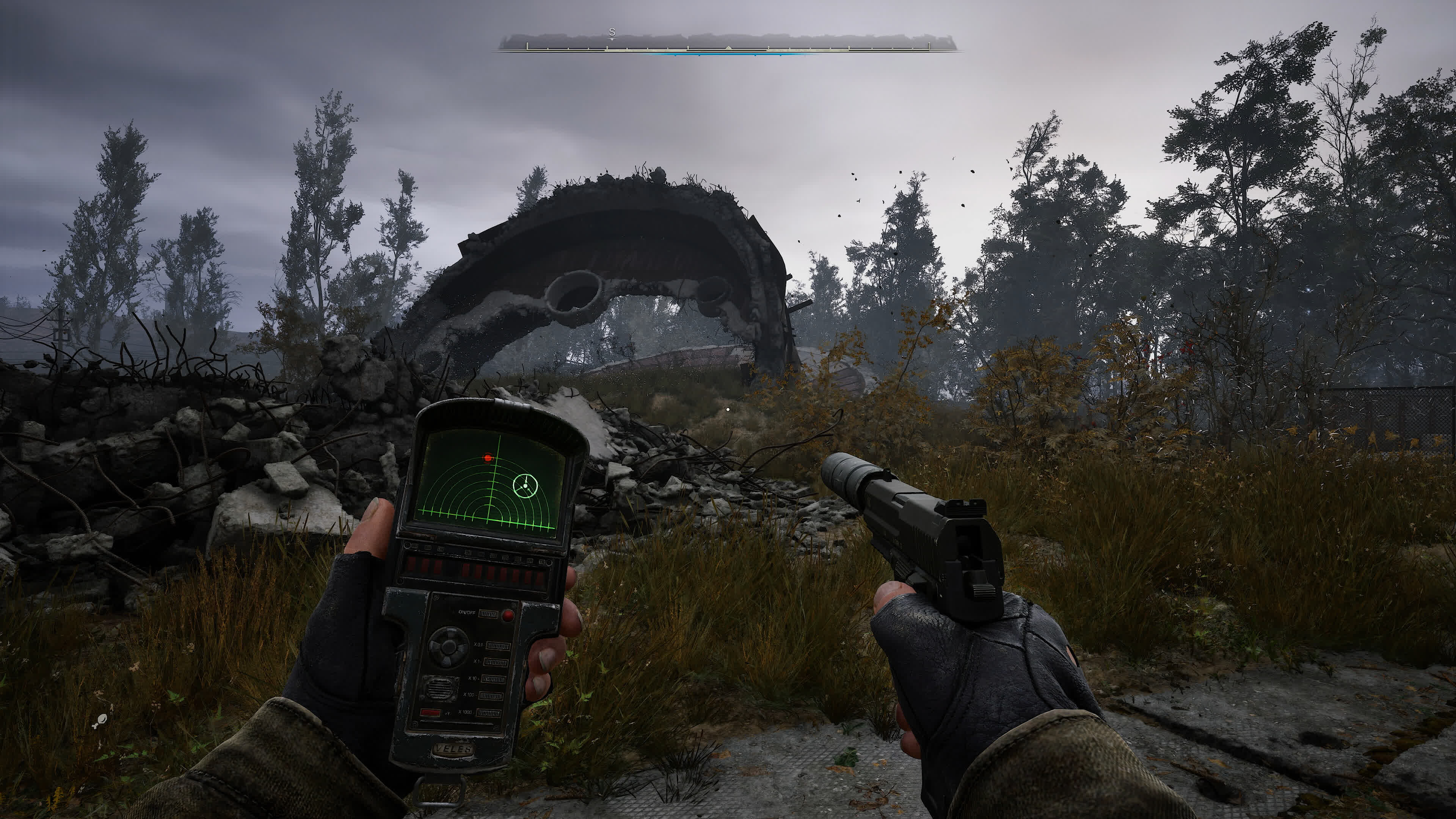
The 8 GB version, nonetheless, battles considerably in this scenario and requires going down to the High pre-programmed, which is a sensible concession. Nevertheless, it feels less so when you’ve spent $ 400 on an RTX graphics card.
The floaty controls and “reasonable” animations make this game especially ideal for framework generation, which can boost the smoothness of CPU-intensive locations without totally addressing the latency problems of pc gaming at or listed below 60 fps.
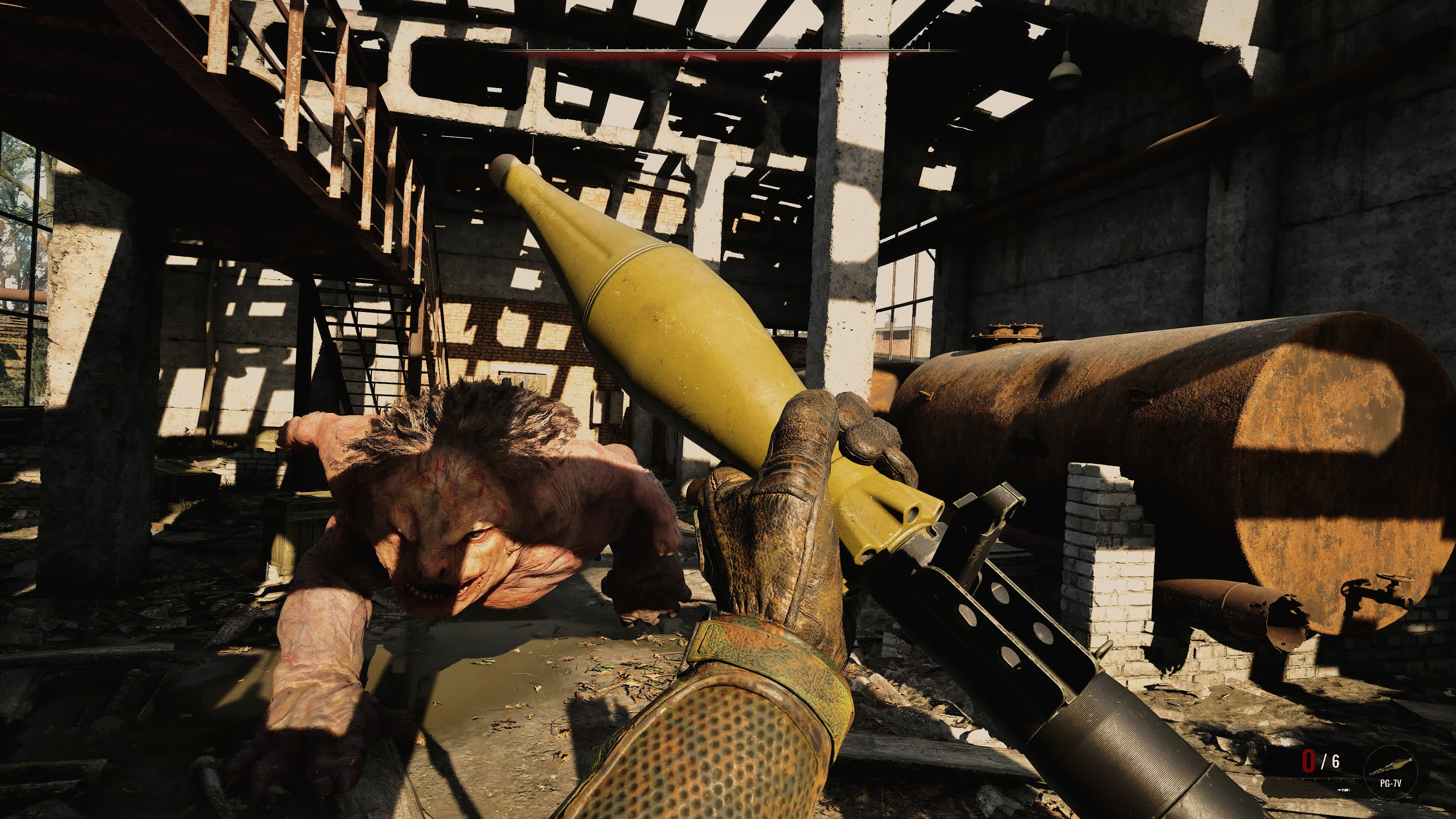
On that note, framework generation is basically unusable with 8 GB graphics cards– at least with the Legendary predetermined, even at 1080 p.
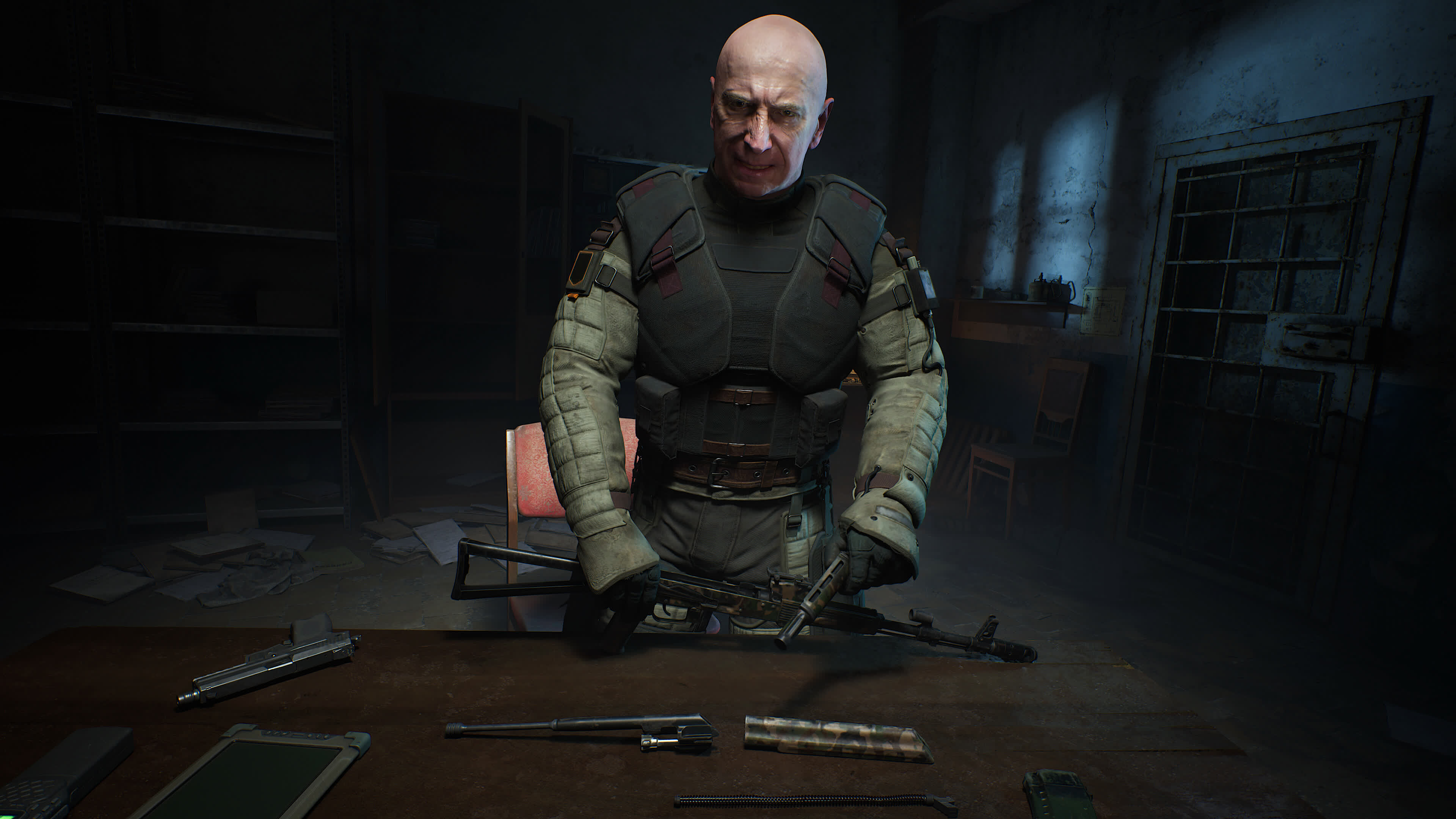
There are also concerns with the High predetermined at 1440 p, as VRAM usage frequently goes beyond 8 GB and, in some cases, climbs up above 9 GB. Once more, this highlights how 8 GB models commonly cause an endangered experience. If these cards had been furnished with 12 GB or, ideally, 16 GB of VRAM, these issues would be unneeded. As Jensen would say, it “just functions.”
If you appreciated all the testing we put into this benchmark review, please share it, subscribe to our e-newsletter to get news of future write-ups such as this one, and look into our TechSpot Elite registration choice for ad-free surfing and added perks.
Purchasing Shortcuts:
- Nvidia GeForce RTX 4070 Super on Amazon
- AMD Radeon RX 7800 XT on Amazon
- Nvidia GeForce RTX 4070 Ti Super on Amazon
- AMD Radeon RX 7900 XT on Amazon
- Nvidia GeForce RTX 4080 Super on Amazon
- AMD Radeon RX 7900 XTX on Amazon
- Nvidia GeForce RTX 4090 on Amazon



